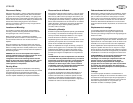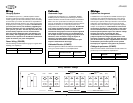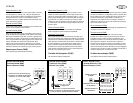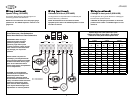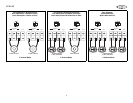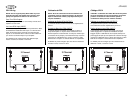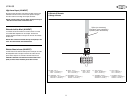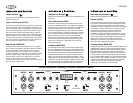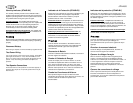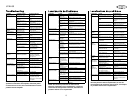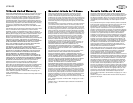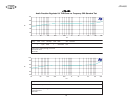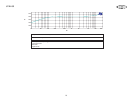
JPA460
14
Indicateur de la protection (STAND-BY)
S'allume en cas de problème et pour signaler que le circuit
de protection a coupé l'alimentation à l'amplificateur pour le
protéger. Eteindre le système et corriger le problème avant
de rallumer l'appareil.
Protection thermique
: L'amplificateur s'éteindra si sa
température devient trop élevée et nuit à la sécurité de
fonctionnement. Il se rallumera quand il se sera refroidi et
revenu à une température normale. Faire très attention, car
la surface de l'amplificateur peut être brûlante.
Protection contre les sourts-circuits et les surcharges
:
L'amplificateur s'éteindra en cas de court-circuit, ou si le
courant atteint une intensité dangereuse.
Preuves
Avant finir l'installation vous devez faire la preuve suivante:
pour que vous vous assurez que lecâblage est
convenablement fait et que tout est en agissant de façon
appropié.
Brancher de nouveau la batterie
Quand le câblage est complètement fait, brancher de
nouveau la borne négative de la batterie.
Epreuve le câblage d'energie
Mise en marche le récepteur mais n'augmente pas le
volume. La lumière d'energie du amplificateur devrait
s'allumer. Si ne s'allume pas, révise le REM et le câble + 12
V. Vous augmentez le volune du récepteur et tous les
parlants devraient être en action. Sinon révise les
connexions du clâvage dans l'amplificateur et les hauts-
parleurs.
Epreuve les connexions du clâvage
Celle- ci épreuves assurent que les hauts-parleurs sont
branchés convenablement. Si les hautsparleurs ne
s'écoutent pas, un ou les deux câbles des hauts-parleurs
peuvent être déconnectés.
Stand-by Indicator (STAND-BY)
The stand-by indicator provides a visual indication that a
problem exists and the protection circuitry has protected the
amplifier by shutting it down. Turn the system off and correct
the problem before turning the system on again.
Thermal Protection
: The amplifier will shut down if its
temperature exceeds a safe operating level. The amplifier will
remain off until it cools to a safe operating temperature.
Exercise care, as the exterior of the amplifier may get
uncomfortably hot to the touch before shutting down.
Overload and Short Circuit Protection
: The amplifier will
shut down if a short circuit condition exists or if electical cur-
rent demands exceed safe levels.
Testing
Before finishing the installation, perform the following tests to
make sure the wiring is correct and everything is operating
properly.
Reconnect Battery
When wiring is complete, reconnect the battery negative terminal.
Test Power Wiring
Turn on the receiver, but do not turn up the volume. The amplifier
power light should come on. If not, check the REM and +12V
wires. Turn up the receiver volume slightly. All speakers should
operate. If not, check wiring connections at amplifier and
speakers.
Test Speaker Connections
These tests make sure the speakers are connected properly. If
speakers don’t play at all, one (or both) speaker wires may be
disconnected.
Indicador de la Protección (STAND-BY)
Proporciona una indicación de que existe un problema y los
circuitos de protección han protegido el amplificador
desconectándolo. Desconecte el sistema y corrija el
problema antes de volver a encenderlo.
Protección Térmica
: El amplificador se desconectará si su
temperatura supera un nivel seguro de funcionamiento. El
amplificador permanecerá desconectado hasta enfriarse a
una temperatura segura de funcionamiento. Tenga cuidado,
el exterior del amplificador puede estar desagradablemente
caliente al tacto antes de desconectarse.
Sobrecarga y Protección Contra Cortocircuitos
: El
amplificador se desconectará si existe una situación de
cortocircuito, o si las demandas de corriente eléctrica
exceden los niveles de seguridad.
Pruebas
Antes de finalizar la instalación, usted debe realizar la
siguiente prueba para asegurarse que el cableado esté
correctamente realizado y que todo está operando
correctamente.
Reconectar la Batería
Cuando el cableado esté totalmente realizado, reconecte el
terminal negativo de la batería.
Pruebe el Cableado de Energía
Prenda el receptor pero no suba el volumen. La luz de
encendido del amplificador debería encenderse. Si no lo
hace, revise el terminal remoto y el cable +12V. Suba
ligeramente el volumen del receptor. Todos los parlantes
deberían estar operando. Si no, revise las conexiones del
cableado entre amplificador y los altavoces.
Pruebe las Conexiones del Altavoz
Estas pruebas aseguran de que los altavoces estén
conectados correctamente. Si los altavoces no suenan, uno
o ambos cables de los altavoces pueden estar
desconectados.



